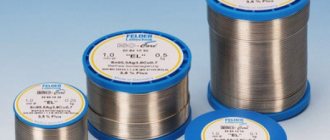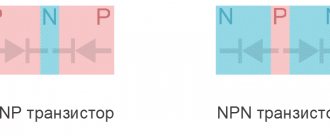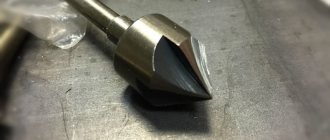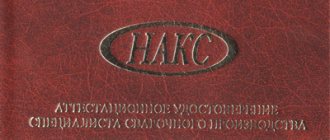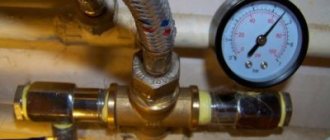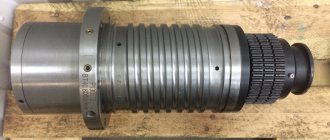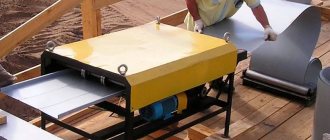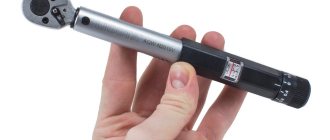One of the most “bearded” jokes from chemistry students: “Aluminum is like iron, only light.” But seriously, periodic element No. 13 is the lightest metal that can exist in its pure form in the air atmosphere. Relative chemical inertness is ensured by a thin film consisting of oxide and hydroxide, which passivates the surface and prevents further reaction with atmospheric oxygen or weak solutions of alkalis and acids.
Distinguishing aluminum from galvanization
In order to reduce the load on supporting structures, they are often made of aluminum. It is easy to distinguish aluminum from galvanized steel, especially if the buyer is not presented with a finished assembly, but with blanks made from rolled sheets or profiles. Main methods:
- By density/weight. The density of aluminum (2700 kg/m3) is almost three times less than the density of steel (7600...7900 kg/m3).
- In terms of surface hardness, aluminum is softer, and when scratched it will leave a deeper groove on a smooth surface.
- According to the effect on the tissue organs of the fingers. The thinnest film of aluminum dioxide upon frictional contact with wet skin of the hands will leave particles of aluminum on the surface of the fingers. When you touch them to a sheet of clean paper or cardboard, dark gray stripes will remain on it.
Externally, aluminum looks more silvery than steel, especially hot-rolled steel.
We distinguish between galvanized and non-galvanized steel
Both stainless steel and galvanized steel are characterized by good resistance to corrosion, so for short service life of structures (up to 10 years), the lower price of galvanized steel can be the decisive choice. It’s a different matter if the design is designed for a shorter period of use, and there is a reason to use ordinary steel. In such cases, it may be necessary to distinguish galvanized steel from non-galvanized steel.
A simple test will help you determine the difference between regular and galvanized steel:
- Prepare a solution of three parts table salt (not iodized!) and one part warm water.
- Dip a clean rag/cloth napkin into the solution and wipe the surface of the steel being tested with it.
- We keep the sample for 24 hours in a normal room at room temperature (you can’t leave it in the sun).
- We inspect the sample: if there are no traces of rust on it, and the surface texture is not uniform in the treated and untreated areas, then this is galvanized steel.
The basis of the test is that as a result of galvanic galvanizing - hot or cold - zinc actively penetrates deep into the base metal, introducing itself into its structure, which acquires anti-corrosion resistance. Ordinary steel does not have such a protective coating, so a saturated saline solution activates the oxidation process with the formation of light red iron oxide.
Another way to distinguish galvanized steel from non-galvanized steel is based on the different magnetic properties of the metals. Zinc, for example, is non-magnetic, so by applying a regular magnet to the unpainted surface of a workpiece, you can determine whether it contains zinc or not.
If the surface of the workpiece is already painted with heat-resistant paint, a magnet will not help. Laboratory testing is required. The greatest accuracy will be obtained by testing for electron paramagnetic resonance (EPR). EPR shows the content of material molecules on an oscilloscope, so galvanized steel will have a high zinc content on the outer surface and its presence in the inner layers. When painting, no zinc will be found in the coating.
Another method is to take a microphotograph of a ground cross-section of the sample. When galvanizing, three intermetallic layers are clearly visible in the structure, which are absent in conventional steels.
In conclusion, we will present an exotic method - you just need to... lick the steel surface. Galvanized steel, unlike ordinary steel, has a chalky aftertaste, and a very distinct one.
We distinguish between galvanized and stainless steel
It is not easy to visually distinguish stainless steel from galvanized steel, since the difference in density is hardly noticeable (as is the appearance of the metal). The following types of tests must be used:
- For mechanical strength in the original state. Most grades of stainless steel have a tensile strength of at least 450 MPa. For galvanizing, this figure is much lower - up to 300...350 MPa.
- For hardness according to Brinell HB. For stainless steel, normal values are considered to be HB 230...300, for galvanized steel - HB 200...250.
- For plasticity. The specific force at which cracks appear on the workpiece is 170...230 MPa for galvanized steel, and 350...400 MPa for stainless steel.
If mechanical tests are not enough, chemical tests are carried out using hydrochloric acid. The method is based on the properties of zinc, which, when interacting with a galvanized sheet coating, actively releases hydrogen. A small drop of hydrochloric acid is enough for the galvanized surface to begin to bubble, and the zinc layer gradually disappears. The surface of stainless steel is chemically inactive.
Electromagnetic differences between galvanized and stainless steel can also be used for evaluation. If a magnet is attracted to the workpiece, then with a high degree of certainty we can say that it is galvanized steel, while most stainless steels are non-magnetic.
Diagnostics
One of the key methods for determining the acidity of the stomach is to conduct a urease breath test to identify the bacterium Helicobacter pylori. Also, PCR and ELISA studies are performed to identify antibodies to this microorganism. Other mandatory research methods for suspected gastritis with high acidity include:
- Endoscopic examination of the stomach (gastroscopy). Using this method, the condition of the stomach, esophagus and duodenum is assessed. If necessary, during the examination, fragments of the mucous membrane are taken (biopsy).
- Intragastric pH-metry. To conduct the study, a pH-metric transnasal probe is used, which is connected to an autonomous recording unit. If the pH of the gastric contents is less than 1.5 units, then the diagnosis of hyperacid gastritis is confirmed.
An ultrasound examination of the abdominal organs may be prescribed as an auxiliary examination method.
Magnetic impact test
While steel, cast iron and iron will be attracted to a magnet, aluminum will not. Therefore, it is quite easy to distinguish this metal from others simply by applying a magnet to it. We remember that copper also does not react to a magnetic field. But these two compounds are clearly different in color, so you definitely won’t confuse them with each other.
The only drawback of this method is the inability to isolate the alloy. If it contains a high aluminum content, the magnet will not affect the scrap, but its purity will need to be determined additionally.
Galvanic galvanizing or how to remove corrosion on a car
It is easy to distinguish aluminum from other metals due to its lightness. The metal is widely used and is in demand in the industrial and food industries. It is not difficult to distinguish zinc from aluminum on your own. To do this, it is enough to have the necessary knowledge and techniques. We invite you to familiarize yourself with them in more detail.
How to distinguish zinc from aluminum?
Alternative options to answer the question of how to distinguish zinc from aluminum, available at home, are the following.
- Recognition by physical and chemical characteristics
Minimum school knowledge is sufficient to determine the composition and variety of an element. Aluminum has a silver tint, is light weight, and flexible. Zinc has a bluish tint, is heavier than the previous material, and does not bend under normal conditions. Fragile, breaks quickly.
- Determination by density parameters
To determine the type of metal by density, you will need a measuring cylinder and water. The essence of the technique is to gradually immerse the product in liquid.
When a body is immersed in water, a certain amount of liquid is released. Using the simplest physical formula allows you to calculate the density of the material. The rest is left to the tabular data.
If the resulting figure is close to 2.7/ml, then you have 100% aluminum.
- Metal detection by magnet
Many elements are attracted by a magnet. However, this property does not apply to Al. Therefore, to determine the quality characteristics, it is enough to bring a magnet to the product. If the metal does not react in any way, and it has a silvery tint, then this means aluminum.
https://www.youtube.com/watch?v=qb2S-4FghTM
The only negative aspect of the technique is the impossibility of isolating the alloy. If it contains a large amount of aluminum, the magnet will also have no effect on it. Therefore, additional methods will have to be used to determine the purity of the alloy.
- Thermal conductivity testing
The thermal conductivity parameters of aluminum are much higher than those of other elements of the periodic table. Therefore, the same volume of liquid under the same conditions in an aluminum pan is brought to a boil much faster. The maximum melting point of Al is 660 degrees.
- Recognition of aluminum by chemical methods
Al is easy to determine. It is enough to apply alkali to a previously cleaned surface. After some time, the surface will oxidize, which can be seen visually.
A similar reaction occurs when metal is exposed to acid, including lemon juice. The aggressive effects of acid are manifested by the appearance of dark gray spots that disturb the appearance of the product.
What type of scrap is accepted, its purity and requirements for it
Meanwhile, the interest of buyers extends to the following categories of this metal:
- “zero” or used factory pigs;
- carburetors disassembled or not;
- furniture fittings of any type (lock connectors, handles, holders) require strict separation from engineering waste.
The most convenient form of raw material for the manufacture of products from Zn
The bulk of products consisting of this metal are produced using powder metallurgy methods or conventional casting. Therefore, zinc factory pigs, which have a convenient shape for storage and transportation, are the most popular type of metal waste. The pigs melt easily and are processed into powder. Hence the higher price than other forms.
Carburetors: to disassemble or not
The requirements for metal purity are sometimes surprising. It is better to remove steel rods in radiators in advance and hand them over as a separate type of raw material, otherwise the price of zinc scrap is reduced by about 25%. This applies to wiring and other debris, but no contradictions arise here.
Product purity
Also, if you want to sell zinc scrap, you will have to inquire about the degree of alloying of your own goods. Because the pure metal category must contain at least 99% zinc. This can include the following types of waste:
- gauge sheets, pipes, foil;
- plates from printing and engraving machines, where up to 1% are associated metals (Fe, Cd, Pb);
- waste from machinery or aircraft equipment;
The degree of blockage, as well as the acceptability of the presence of certain impurities, are discussed individually.
More clogged types include:
- varieties of TsAM scrap with a low dose of alloying (up to 3%) or containing a high proportion of impurities;
Zinc alloy housing
- bimetallic waste with a Zn content of at least 85%;
- types of dross, including zinc-lead alloys;
- also some batteries, despite the low proportion of zinc, only 20%.
They accept everything, but at a reduced price
The price for zinc scrap today is 50-70 rubles per 1 kilogram.
Difference from alloys
To distinguish between aluminum and alloys based on it (duralumin, TsAM and others), laboratory tests are usually ordered. But there are several ways to do this at home. You need to know that duralumin, unlike aluminum, does not emit a high-pitched ringing sound upon impact and does not have a shiny surface if the top layer is removed. ZAM (an aluminum alloy containing zinc and copper) is isolated by a simple test with hydrogen peroxide. It is in almost every first aid kit. Apply a few drops of peroxide to the cut. For aluminum it will remain the same, for TsAM it will darken.
In this article we told you how to distinguish aluminum. If you want to get advice on how to profitably hand over this metal to collection points, please contact our specialists. Phone numbers are listed on the website. We are waiting for your calls!
Where can you find aluminum scrap?
Aluminum pans, cutlery, familiar from childhood, and even chocolate foil are not a complete list of products that are made of aluminum. During the Soviet era, the price of aluminum products did not correspond in any way to its real value, which formed the erroneous opinion that this material was cheap. In any garage or shed there will be dozens of aluminum items: window fittings, old aluminum radiators, bicycle parts, camp kettles and pots, cable remnants - the list goes on for a long time. Due to the mismanagement of the 80-90s, even whole ingots of commercial aluminum can be found in industrial landfills.
This metal is of strategic importance for the national economy. Industrial production is carried out by melt electrolysis, which is associated with huge energy costs. Recycling recycled materials is much cheaper (energy savings of up to 75%, reduction of harmful emissions into the atmosphere - up to 90%), in addition, this metal can be melted down many times without deteriorating its physical properties. Aluminum scrap is purchased without restrictions at almost all scrap metal collection points and is much more expensive than ferrous metal scrap. After receiving, further sorting is carried out, after which the secondary raw materials are classified and assigned a class, group and grade. The total number of varieties of aluminum secondary raw materials exceeds 20 items.
How to distinguish zinc from aluminum?
Zinc is much heavier than aluminum, aluminum is light-colored. And zinc is darker, and the color is very similar to that of pouring gasoline into a puddle, the same color patterns on the surface of zinc. Carburetors used to be made of zinc.
Zinc supplements do not affect bad breath (halitosis). They can be prescribed for dermatitis, baldness (alopecia), and zinc deficiency. For halitosis, toothpastes and rinses containing hexetidine and cetylperidinium chloride, which have a local antibacterial effect and reduce the number of anaerobic bacteria, can be prescribed.
High zinc content in:
- dried watermelon seeds (this product is popular in Asia and the Middle East)
- cocoa powder and chocolate
- lamb
- beef
- oysters
- peanuts
- pumpkin seeds
- sesame
- calf liver
- wheat germ
Zinc is one of the most important microelements for humans; it is part of all existing enzyme systems of the body, participates in the growth, division and differentiation of cells, in addition, it is of great importance in the maturation of the skeletal system, and is also extremely important in the process of tissue regeneration after burns and wounds
If a child lacks zinc, he grows more slowly, has weak bones, and does poorly at school. In both children and adults, zinc deficiency reduces performance. Lack of zinc in the body of boys and men can lead to infertility. since zinc is necessary for the full functioning of the gonads and, in addition, for the production of sperm. Zinc is also necessary for men for the full functioning of the prostate gland; if there is a lack of the element, an inflammatory process can develop, and subsequently prostate adenoma.
Zinc is a very important trace element. Participates in metabolism. Acts at the cellular level. Large amounts are found in seafood.
Daily requirement of zinc
This norm was introduced back in the 70s.
| For a child | 5-10 mg |
| For woman | 12 mg |
| For a man | 15 mg |
In general, the dosage is prescribed by the doctor. Zinc is needed in increased portions by pregnant women, nursing mothers, and athletes. And vegetarians should at least take vitamins that contain it.
Properties and characteristics of zinc and zinc alloys
The characteristics of zinc alloys are largely determined by the properties of zinc. This metal is bluish in color, is not found in its pure form, and usually contains impurities that change its properties. Pure metal is obtained as a result of several reactions.
Zinc has the following chemical properties:
- When heated, it reacts with hydrogen sulfide and water to release hydrogen.
- Does not react with nitrogen and carbon.
- It reacts with alkalis to form zinc acid salts - zincates.
Zinc is a very durable material. Its ductility increases when heated. If it is heated by more than 210 degrees, this may change its shape. At low temperatures the substance melts.
What does zinc alloy look like?
The amount of impurities depends on the methods of metal extraction, the characteristics of its processing and the zinc grade. Most often you can find impurities in the form of nickel, chlorine, fluorine and lead. Usually, when creating zinc alloys, pure zinc is used, since the presence of impurities degrades the quality of the material:
- tin makes the alloy too brittle and brittle;
- in the presence of cadmium, the ductility of the material decreases;
- lead increases intercrystalline corrosion of the material and promotes its dissolution in acids;
- the presence of iron increases the hardness of alloys, but reduces their ductility;
- Arsenic causes the alloy to become brittle and non-ductile.
Therefore, to improve the characteristics of zinc alloys, zinc is first purified from impurities. And then they use pure metal, which is alloyed with various components.
Advantages and disadvantages
Most zinc alloys have the following advantages:
- they are very durable and are not damaged by mechanical stress;
- resistant to corrosion;
- have good casting qualities and can be used to create even small elements;
- Over time, they practically do not age.
However, even small amounts of impurities worsen the characteristics of the alloy. They lead to a decrease in melting point, swelling, and contribute to the appearance of cracks. Therefore, zinc alloys must be created in compliance with all technologies, and the amount of impurities in them should not exceed 0.005%.
Many people ask whether zinc alloys darken or not? This is another drawback of the material. Zinc alloys may darken over time. Moreover, the darkening usually spreads over the entire surface of the material. This is caused by the formation of an oxide film on the surface of the material. It forms at room temperature after contact with air or water. Therefore, to avoid this, electroplating is required.
Plant foods with zinc
If we talk about types of cereals, special attention should be paid to buckwheat; if we mention flour products, we should mention bread. If there is not enough zinc in the body, you should drink green tea and also eat berries, dates, and apples.
Zinc in cereals and legumes
Beans and lentils are foods whose importance may be underestimated. They are not eaten so often, although they contain many useful elements, including such essential ones as zinc.
Types of zinc alloys
Zinc can be alloyed with various substances, which will determine the properties of the resulting material. Alloying pure zinc with copper, aluminum and tin can improve its performance. The resulting composition will be of higher quality than the pure substance.
Copper and zinc
The copper-zinc alloy is called brass. This alloy has been known for a very long time. It was first made by alloying zinc ore and copper. It was only in the 18th century that an alloy of copper and zinc metal was first created.
Moreover, both components can be taken in different proportions. As a result, several types of brass are distinguished:
- Green. Contains 60% copper and 40% zinc.
- Golden. It contains 75% copper and 25% zinc.
- Yellow. Contains 67% copper and 33% zinc.
Brass is an alloy of copper and zinc.
Brass lends itself well to pressure processing. It is characterized by high mechanical properties and good corrosion resistance. But in air, in salt water and carbon dioxide solutions, brass is unstable and quickly becomes covered with a dark oxygen film.
Scope of application
Zinc alloys are widely used. They are used in the following industries:
- In the automotive industry. Door handles, mirrors, and parts for car interior decoration are made from zinc alloys.
- When creating jewelry. Zinc is alloyed with gold, thereby increasing its ductility and malleability. This makes it easy to connect small parts to each other.
- In medicine. Zinc alloys are used to make medical furniture and devices. And zinc oxide is a good antiseptic, so it is added to various ointments and medicines.
Zinc alloy is used in automobile manufacturing
. Thus, zinc and its compounds are used in many fields. But the substance is most widely used in the automotive industry.
Types of zinc alloys by purpose
According to their intended purpose, zinc alloys can be of several types:
- Deformable. 15% - aluminum, 5% - copper, more than 1% - magnesium. It is made in the form of sheets or rods. The properties are similar to brass.
- Foundries. They are made by adding 3-4% copper and aluminum to zinc, as well as 0.05% magnesium. They have good fluidity. Therefore, they are manufactured through injection molding or mold casting.
- Anti-friction. They contain 10% aluminum, 5% copper and 0.1% magnesium. Manufactured by injection molding. They have a low coefficient of friction and are used in the automotive industry.
- Solders. They are used for soldering aluminum parts. Usually include impurities - metals. This increases their strength.
- Typographic. They contain 7.5% aluminum, 2% magnesium and approximately 4% copper. Such alloys are very durable and cast well into molds.
- Protective. They contain no more than 1% aluminum and a tiny amount of silicon and magnesium. Resistant to corrosion even in damp environments. Therefore, such alloys are used as protective materials.
Zinc alloy in jewelry
Externally, zinc alloys resemble noble metals. Therefore, they are used in costume jewelry to create inexpensive jewelry. Zinc alloy jewelry looks expensive but is easy to create.
Is zinc alloy harmful? In fact, it has no effect on the human body. But, nevertheless, it is better to purchase good quality jewelry. Usually, a special alloy is used to create jewelry, which is called costume jewelry. The most commonly used is brass or an alloy with aluminum. Externally, such products resemble gold and silver.
Is zinc alloy harmful in jewelry? No, so you can safely buy products made from it. After all, if it had a negative impact, making jewelry from it would be prohibited.
Thus, zinc and zinc alloys are widely available. They are used in medicine, automotive industry and even in jewelry. These are high-quality and sustainable materials that practically do not change under the influence of environmental conditions.
Zinc-containing animal products
The element necessary for the body is found in many of the most common food products: grains, different types of nuts, fish and meat foods, wheat bran. Moreover, it is found in almost all yeast, as well as in poultry meat, inside onions and garlic, and in vegetables (only fresh).
Nuts and plants are, of course, rich in this element. But nutritionists believe that the most zinc-containing foods are meat and fish. Plant foods also contain zinc, but animal products are more abundant.
Among animal products, mention should be made of the egg yolk, which contains as much as four milligrams of this element per hundred grams of the substance, as well as dairy products. It can be milk, kefir, sour cream, and yogurt. Zinc is also found in sausages, but only in natural ones.
Zinc in meat products
From meat, this is, first of all, chicken heart, fried lamb liver and kidneys. Beef, pork, and lamb are classic examples of high-calorie foods that contain elements necessary for the body, including zinc.
Zinc in seafood
The most zinc-containing fish products are seafood products. And anchovies contain three and a half milligrams of zinc per hundred grams. Sardines, tuna, oysters are both tasty and healthy products containing useful microelements. Tuna in oil is a real delicacy, and salmon can be preserved and eaten for dessert for a long time.
